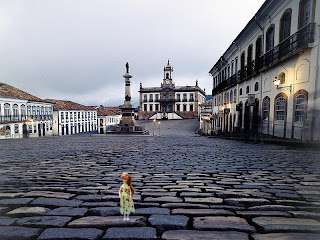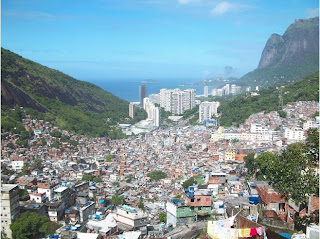Ouro Preto, Minas Gerais!!!
No comecinho do Brasil, só o nordeste era mais povoado e interessante economicamente para Portugal, por causa dos engenhos de açúcar. Salvador, na Bahia, era a capital da colônia.
In the very beginning, only the Northeast of Brazil was 'populated' and considered economically interesting to Portugal, because of the sugar cane mills.
Minas, o estado, nem existia! Goiás, Mato Grosso, São Paulo e Paraná eram todos uma coisa só: São Paulo. E os bandeirantes desbravam todo o interior em busca de riquezas e tentando escravizar os índios. Aí um dia acharam ouro. Ouro de qualidade (23 quilates), no leito dos riachos entre as colinas das serras... Então, todo mundo disse ser dono daquela terra! Para resolver o impasse, foi criado o novo estado: Minas Gerais. E sua capital ficou sendo o vilarejo que mais produzia ouro: Vila Rica.
The state of Minas Gerais didn't even exist yet! Goias, Mato Grosso, Sao Paulo and Parana were all only one thing: Sao Paulo. And the "Bandeirantes" ('pioneers') used to explore all the countryside searching for hidden treasures and trying to enslave the native tribes. One day they found gold. Good kind of gold (23 carat), easy to pick, in the riverbeds that flew amidst the hills... Then everybody claimed to own those lands! To solve the conflict, a new state was created: Minas Gerais (General Mines). And its capital became the village which produced the highest amount of gold: Vila Rica (Rich Village).
Declarada patrimônio cultural da humanidade, a cidade comemorou 300 anos de existência em 2011 e ainda preserva suas características da época colonial, com 10 igrejas e 20 capelas espalhadas pelos seus morros, todas no estilo barroco. Suas ladeiras de pedras irregulares e passeios estreitos de pedra são uma verdadeira academia ao ar livre!
There is practically no more gold left, but it was declared 'cultural patrimony of mankind'. The city celebrated 300 years of existence in 2011, and it still has its original characteristics of the colonial era. There are 10 churches and 20 chapels scattered all over the hills of the city, all of them in the baroque style. Its steep streets are paved with irregular pebbles and the narrow sidewalks are made of stone. The whole city is a true outdoors gym!
O ouro deslocou o eixo econômico para o sudeste, e Rio de Janeiro tornou-se a capital, para melhor escoar a produção de ouro e pedras preciosas.
All that gold shifted the economical axis to the Southeast of Brazil, and Rio de Janeiro became the new capital of the country. It was more strategically placed to control and ship the gold and gems that would pour from this area.
Mas logo o ouro fácil dos riachos acabou, e começaram a cavar as minas. Nelas o ouro vinha incrustrado em rochas de oxalato de ferro. Como a pedra é escura, é chamado de 'ouro preto'. Daí ficou sendo este o novo nome da cidade... Em um vilarejo próximo o ouro vinha encrustrado em cristais de quatzo, que é branco. Adivinhe o nome da cidade: 'Ouro Branco', claro! rsrs...
But the easy picking gold from the creeks soon ended, and it became necessary to dig mines. In them the gold was embedded in iron oxalate rocks, which is dark black. So this kind of gold was called "Black Gold". This ended up being the new name of the city... ('Ouro Preto' means 'black gold') In a nearby village, the gold extracted was usually embedded in quartz crystal, which is white. Guess the name of that town: "Ouro Branco" (White Gold), of course!... :)
 |
| ouro preto x ouro branco black gold x white gold |
One of the best tours is the steam locomotive. A delightful 11 miles ride connecting Ouro Preto to Mariana. It was built between 1883 and 1914, and refurbished in 2006. We caught the 10am train to be back with the 2pm one.
 |
| MJ: "Venha logo, ou você vai perder o trem!!!" MJ: "Hurry, or you'll miss the train!!!" |
In the skirts of Mariana, we visited 'Mina de Passagem' ("passage mine"). 35 tons of gold were extracted from this mine. Nowadays it's just another touristic place. We rode a trolley to go through its 344 yards length, going as deep as 131 yards.
Fizemos um lanchinho por lá e MJ adorou o mineiríssimo 'pão de queijo'. E sua sobremesa favorita agora é oficialmente 'doce de leite', de preferência com um pedacinho de queijo de minas (ou queijo fresco, como chamamos por aqui!)
We had a snack there and MJ just loved the most 'mineiro' food of all: "pão de queijo" (cheese rolls). Made from manioc flour and local cheese. And according to her, her new favorite desert is now officially "doce de leite" (milk fondant), preferably served with a chunk of fresh cheese...
 |
| pão-de-queijo, que delícia! freshly made 'cheese rolls', yummy! |
 |
| MJ não resiste ao doce de leite com queijo fresco! MJ can no longer resist 'milk fondant' with fresh cheese! |
 |
| queijo minas (ou queijo fresco) Fresh cheese. |
Back to Ouro Preto, we visited the street market and the various stores which sell crafted objects made of soapstone. When recently extracted from the ground, it is soft and can be sculpted just like wood. Exposed to air, it hardens and becomes rock solid! Practically all sculptures in the city were made of this peculiar material.
Um dos artistas mais conhecidos do Brasil e cujas obras em pedra-sabão enfeitam vários pontos da cidade foi "Aleijadinho" (Antônio Francisco Lisboa, viveu entre a década de 1730 até 1814) filho ilegítimo mas amado de um dos maiores arquitetos da cidade com uma escrava. Não herdou sua fortuna, mas sem dúvida o talento. Em 1777 os sintomas de uma doença degenerativa não diagnosticada começou a deformar seu corpo, mas não o impediu de criar suas belas obras. Outro artista da época foi Mestre Ataíde (Manuel da Costa Ataíde, de 1762 a 1830), que tem várias pinturas e afrescos pela cidade.
One of the best known local artists and whose sculptures in soapstone are all over the city was 'Aleijadinho' ("the crippled"), the nickname Antonio Francisco Lisboa (1730's to 1814) is better known. He was an illegitimate son of a wealthy and famous architect and a slave. He loved his son and set him free, but no other rights were granted. Aleijadinho did not inherited his wealth, but was the only one to inherit his father talent and got even more famous than him! In 1777 a mysterious degenerative disease started to deform his body, but he never stopped creating. Another artist of that time, whose paintings and afrescoes are all over town was 'Mestre Ataíde' (Manoel da Costa Ataíde, from 1762 to 1830).
 |
| "Tem certeza que é pedra-sabão? Não tem cheiro nem toque de sabão!" "Are you sure this is 'soapstone'? It does not feel or smell like soap!" |
Besides the famous 'prophets', there are also sculptures by Aleijadinho decorating numerous water fountains all over town. Those were vital to supply the population with water, as there was no piped water back then. They were also a 'meeting place' for the neighbors. The female slaves were the ones responsible for bringing back home huge barrels full of water on the top of their heads.
 |
| MJ descansa ao lado de um chafariz antes de enfrentarmos outra ladeira... MJ catches her breath by a water fountain before we face another steeply street... |
Talking about slaves, it is possible to visit some 'senzalas' (slave quarters), where they were confined after a long labor day... So sad, isn't it?
No final do dia, antes de irmos embora, uma foto da praça Tiradentes. Revoltados com os impostos cobrados por Portugal, alguns amigos muito ricos começaram a conversar sobre declarar a independência de Minas. Foram delatados por um 'amigo'. Portugal prendeu todos. Como eram muito ricos, a maioria só foi deportada para a África. O único que foi executado (enforcado e esquartejado) foi Joaquim José da Silva Xavier, que assumiu sua crença na liberdade e assumiu a liderança do 'movimento' para eximir seus amigos. Detalhe: era o único 'classe média' do grupo. Minha família descende da família dele. Depois do ocorrido, retiraram o "Xavier" do sobrenome e várias gerações tiveram medo de tocar no assunto, era tabu. Eu sempre tive orgulho! :)
By sunset, before we left the city, MJ posed on Tiradentes square. Unhappy with the heavy taxes forced upon the local population by Portugal, some very rich friends started to meet and talk about making Minas Gerais an independent country. A 'friend' snitched them and the 'movement' was totally wiped out. Most were deported to Africa. The only one to be executed (hung and dismembered) was Joaquim José da Silva Xavier, who never denied his belief in freedom and took all the 'blame' so as to set his friends free. Note: he was the only 'middle class' in the group... My family, on my mom's side, descends from his family. After those events, they changed their last name, eliminating "Xavier", and for several generations talking about it was a taboo. I have always been proud of my ancestor! :)
 |
| Tchau Ouro Preto!... Bye-bye, Ouro Preto!... |
Para saber mais da história de Ouro Preto:
You can watch this special documentary to know more about and see more of Ouro Preto (yes, it's in Portuguese, but images are worth more than 1,000 words, right?) :)
Veja mais artesanatos típicos em pedra-sabão:
And this video shows some more objects made of soapstone:
Então, está curtindo a viagem tanto quanto nós? :)
So, are you enjoying our trip as much as we are? :)









































